
Downtown, or Islamic, Cairo is the place to see some amazing
mosques. This one, The Mosque of Ibn Tulun is one of Cairo's
oldest, built in 876-79 A.D. Famous for its external spiral
staircase it is believed that the stones used in its construction
where taken from the pyramids.
|
 |
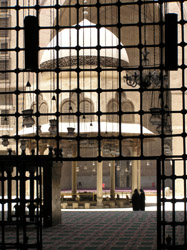
The interior of the Madrasa of Sultan Hassan. The Madrasa,
or religious school, includes a mosque and rooms for instruction.
You can see two traditionally dressed islamic women in the
mosque's forecourt.
|
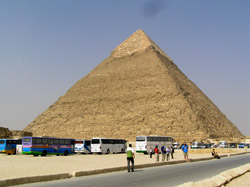
Surprisingly close to the centre of Cairo, in fact only
11kms from the centre of town, the three pyramids of Giza
were as amazing in person as they look on TV. Here you can
see the collection of tourist buses parked at the base of
Khefre pyramid, the second largest of the three and the only
one with any facing stones still intact.
|
 |
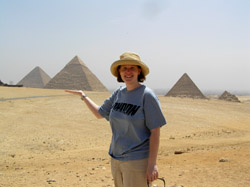
Walk like an Egyptian! Kate does her best to support the
Khefre pyramid as it rests on the Giza plateau, its fellow
pyramids surrounding it.
|
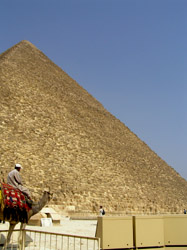
A man on a camel crosses in front of the Great Pyramid
of Giza, with the light boxes for the Pyramid Sound and
Light show in the foreground. Andrew sneakily took this
shot after being hassled by the camel rider to take his
photo (and then pay him money!). You've got to beat the
system however you can in Egypt.
|
 |
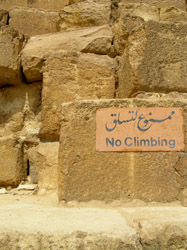
Apparently climbing the remaining Ancient Wonder of the
World is frowned on.
|
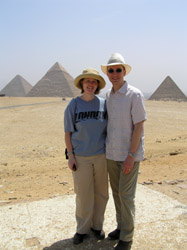
Definitely a highlight of May, us on the Giza plateau.
|
 |
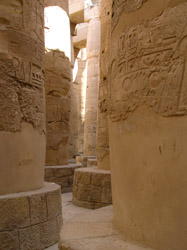
Karnak temple, just out of Luxor, is the second most visited
site in Egypt. This photo was taken in the Hypostyle Hall
which consisting of 134 massive columns 23 meters high.
Nicknamed the Karnak forest it was a very special place
to visit.
|
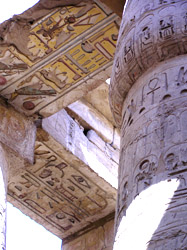
Coloured hieroglyphs on the roof of Hypostyle Hall in
Karnak temple. It's amazing to realise that these inscriptions
are some 3000 years old and still retain their original
colours.
|
 |
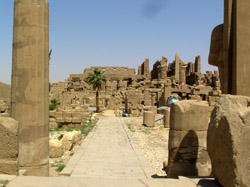
Construction work began on Karnak Temple in the 16th century
BC and approximately 30 pharaohs contributed to the buildings,
enabling it to reach a size, complexity and diversity not
seen elsewhere. Only a small part of the complex is open
to tourists but it still took the better part of 4 hours
to explore it.
|

Kate, on the right in beige hat, prepares to board her
donkey on the way to the Valley of the Kings.
|
 |
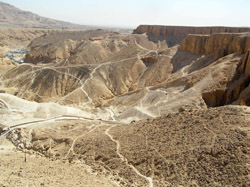
On the opposite bank of the Nile from Luxor and Karnak
Temple sits the Valley of the Kings, burial place of many
of the New Kingdom pharaohs.
|

Entrance to one of the tombs in the Valley of The Kings.
|
 |

Hieroglyphs are just everywhere in Egyptian temples and
we have many, many photos to prove it, here's one of our
favourites.
|
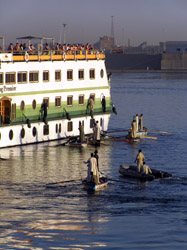
Local merchants make the most of tourists waiting to go
through the lock between Luxor and Aswan. The 'stores' throw
goods up to tourists on the cruise boat sundecks and beseech
people to buy their wares. You can bargain them down and
purchase the goods, or return them, both by throwing the
money/goods back to the boat. This often ends up with goods
in the water as tourists haven't had as much practice as
the merchants!
|
 |
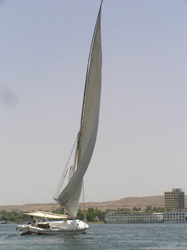
A felucca on the nile. We could have cruised from Luxor
to Aswan on one of these traditional boats but chose a boat
with running water and a toilet.
|

Kate and her amorous camel boy as they cross the desert
heading towards the Monastery of St Simeon.
|
 |
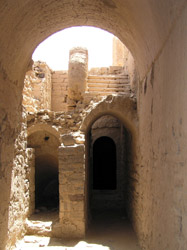
Arched doorways in the now abandoned Monastery of St Simeon.
This coptic monastery was built in the sixth century in
honor of Amba Hadra, a local saint.
|

We had a great group of people on our tour. Here's us
with some of them sitting down to enjoy dinner. No, we did
not dress like this every night!
|
 |
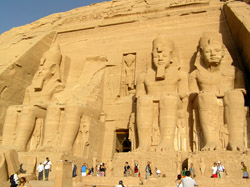
The Great Temple at Abu Simbel is dedicated to Ramesses
II. The temple's facade is dominated by four enormous seated
statues of the Pharaoh (each over 20 metres high), although
one has been damaged since ancient times. It was about 6am
when this photo was taken and about 35 degrees.
|
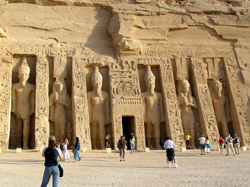
The Small Temple at Abu Simbel was probably completed
ahead of the Great Temple and is dedicated to Ramesses'
favourite wife, Nefertari. At the entrance stand six 10-metre-high
(33 feet) rock-cut statues - two of Ramesses and one of
Nefertari on either side of the doorway.
|
 |
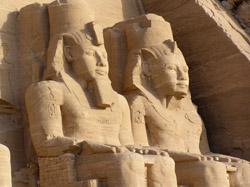
The temples were cut from the rock and shifted to higher
ground in the 1960s as the waters of Lake Nasser began to
rise following completion of the Aswan High Dam. Egypt flooded
an entire country to create the dam and lost many amazing
sites in the process.
|



